|
September 17, 2012 The requested video is no longer available.
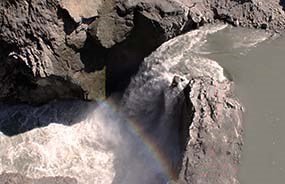
September 12, 2012 Officials do not expect the upcoming blasts to release large amounts of water from what remains of Lake Mills. However, visitors to the area should be aware of the possibility of sudden increases in river flow and avoid low-lying areas near the Elwha River for up to five hours following each blast. 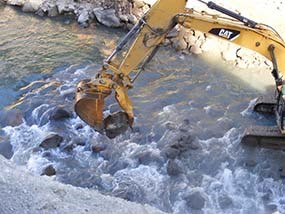
Courtesy of URS Excavating the Last of the Material at Elwha Dam Site Once the channel is clear, workers will only have final clean-up to do before completing work at the former Elwha Dam. August 31, 2012 
Photo courtesy of Washington State Department of Fish and Wildlife. This month Washington State Department of Fish and Wildlife has counted bull trout, steelhead, Chinook, pink, and sockeye salmon in the fish weir on the Elwha River. The weir is part of a multi-agency effort to monitor the influence of removing the Elwha and Glines Canyon dams on salmon and steelhead returns to the Elwha River ecosystem and minimize harm to steelhead and Chinook, both federally listed threatened species, during dam removal. Each fish that passes through the weir is weighed, measured, and counted for the purpose of monitoring the fish populations. Depending on the species, the fish will either pass through and continue on its journey upstream or downstream or be collected and relocated to the clear waters of Little River, the state rearing channel, or the Tribal facility. 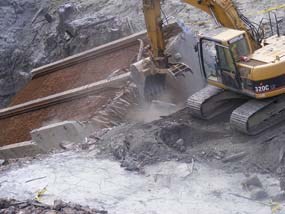
A Quiet Week at the Elwha and Glines Canyon Dams August 24, 2012 
Courtesy of John McMilllan, NOAA-Northwest Fisheries Science Center On Monday, less than five months after the removal of the Elwha Dam, adult Chinook (king) salmon were observed in the park. These are the first observed Elwha River salmon to naturally migrate into the park. When the Elwha Dam became operational in 1913, twenty-five years before the establishment of the park, over 70 miles of habitat were blocked to fish passage. The Chinook were initially observed approximately two miles upstream from the boundary of the park by Phil Kennedy, Lead Fisheries Technician for the park. By Friday, the Fisheries Crew had observed Chinook throughout the first 12.5 miles of the Elwha River, from the mouth of the river to the Altair Bridge, as well as at the mouth of Indian Creek. The Fisheries Crew has been conducting weekly surveys along the Elwha River since the start of August in search of Elwha River Chinook salmon in the park. The return of the salmon marks an important milestone in the restoration of the Elwha River ecosystem and a historic moment in the history of the park. 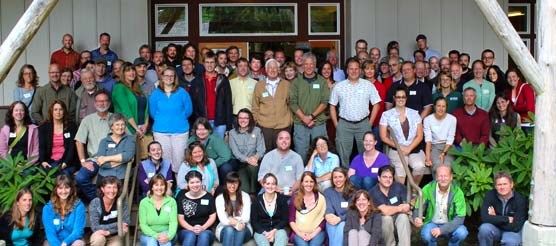
Elwha River Science Symposium Presenters discussed the progress and lessons learned from the first year of the Elwha River Restoration project. Some of the successes reported during the conference included the new formation of sandbars and beaches along the river and at the river mouth, the establishment of willow and alder at sites around Lake Mills and Lake Aldwell, and the observation of both adult and juvenile Chinook above the site of the former Elwha Dam, signaling that restoration of anadromous salmon in the park is underway.
Intake Tower Comes Down At Glines Canyon Dam On Thursday, Barnard continued the process of demolishing of the tower. Two excavators, one equipped with a bucket and one equipped with a hydraulic hammer, are being used in the demolition. Work to remove the intake tower concrete and steel will continue next week. The 'fish window' continues through September 15. During 'fish windows' all reservoir-lowering work is halted in order to protect fish from harmful effects of sediment. The requested video is no longer available.
August 17, 2012 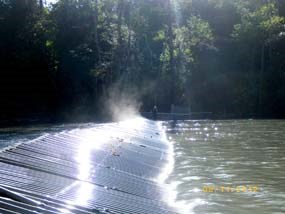
This month Chinook and pink salmon are returning to the Elwha River to spawn. As these fish begin their journey up the Elwha River, they are being collected in a fish weir. A fish weir is a fence-like obstruction placed in a river to direct the movement of fish into a trap. Weirs are essential tools for the management of many fish stocks, especially salmon and trout. The weir installed in the Elwha River is part of a multi-agency effort to monitor the influence of removing the Elwha and Glines Canyon dams on salmon and steelhead returns to the Elwha River ecosystem and minimize harm to steelhead, bull trout, and Chinook, all federally listed threatened species. The weir will enable management staff to get the most accurate and verifiable count of the number and species of fish moving through the system, as well as allow them to collect fish for transport to state rearing channels and clear tributaries above the Elwha Dam, safe havens for the fish while there are high levels of turbidity, or suspended sediment, in the river. The weir was initially installed in the Elwha River in September 2010 to begin counting adult salmon, trout, and char migrating upstream and downstream in the Elwha River. On August 2, the weir was reinstalled for the chinook and pink salmon migration. Since then, sixteen bull trout, three Chinook, two pink salmon, seven steelhead, and one sockeye salmon have been captured in the weir. Over the next few months, fisheries biologists expect 1,500-2,500 Chinook and up to 200 pink salmon to move into the Elwha River. 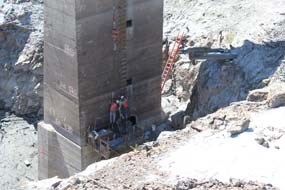
Progress at Glines Canyon Dam Public Events at Elwha River Science Symposium On Wednesday, August 22 at 9:00 a.m a panel of experts will discuss what they've learned during the first year of the project. Panelists include Brian Krohmer, Project Manager for Barnard Construction, Tim Randle, Hydraulic Engineer for the Bureau of Reclamation, George Press, Fisheries Biologist for the National Oceanic and Atmospheric Administration (NOAA), Guy Gelfenbaum, Coastal Geologic and Oceanographic Researcher for U.S. Geological Survey (USGS), Mike McHenry, Fisheries Habitat Biologist for the Lower Elwha Klallam Tribe, and Joshua Chenoweth, Botanical Restorationist for Olympic National Park. The presentations will be followed by a question and answer session with both live and on-line audiences. A live webcast of both events will be available for those who cannot attend in person. More information on the live webcasts can be found at: http://www.pencol.edu/events/elwha-science-symposium. More information on the Elwha River Science Symposium can be found at elwharesearchconsortium.wildapricot.org. River Story Event at Port Angeles Public Library August 9, 2012 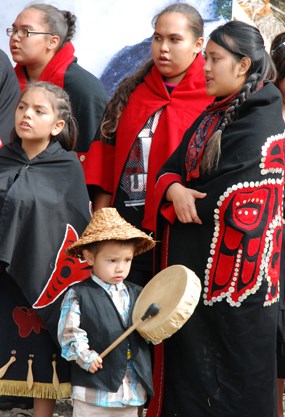
In one of the most significant developments yet in the process of Elwha River Restoration, members of the Lower Elwha Klallam Tribe recently gathered at their people's sacred creation site for the first time in nearly a century. Generations of tribal members handed down descriptions of a distinctive place along the Elwha River where the Creator bathed the people and blessed them. For millennia a place of reverence and vision, the tribe's creation site was covered by the waters of one of the two reservoirs created after construction of the dams in 1910 and 1927. Removal of the two dams on the Elwha River began in September 2011; the Elwha Dam is completely gone and Glines Canyon Dam is expected to be fully removed by early summer 2013. The creation site was located in early July by members of the Olympic National Park cultural resources staff who frequently monitor both of the former Elwha reservoirs for emerging cultural resources. Park staff immediately contacted tribal members who visited the site and confirmed its authenticity. Elsewhere on the Elwha, another significant cultural site was recently found in an area formerly covered by a reservoir. Material from this site was collected for further study and the site was re-buried. Radiocarbon analysis indicates that the spot was used by people as far back as approximately 8,000 years ago, establishing it as one of the oldest known archeological sites on the Olympic Peninsula. Cultural sites and artifacts are protected by laws including the National Historic Preservation Act, the Archeological Resources Protection Act, as well as National Park Service and Department of the Interior policy. Disturbance of cultural sites and artifacts is strictly prohibited and is punishable by law. 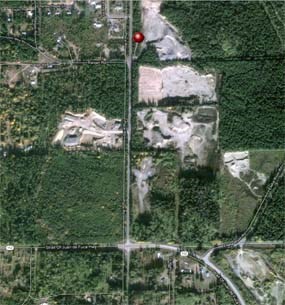
Own a Piece of the Dam 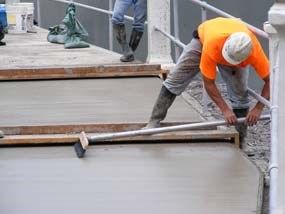
Preparing for Life After Dam Removal Other work being done at the Glines Canyon Dam this week included removing a log jam from the top of the dam, filling and grading at the base of the left abutment, and preparing for the next blast. Next week, crews will prepare the intake tower for removal. 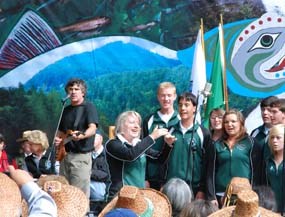
Dana Lyons in Concert at Port Angeles Library August 3, 2012 
Last week, on July 29 and 31, two controlled blasts were used to notch and lower Glines Canyon Dam. Together, the blasts lowered the reservoir from 496 to 490 feet. A total of six controlled blasts in July lowered the reservoir a total of 24 feet, from a starting elevation of 514 feet to a final elevation of 490 feet. Today, approximately 90 feet of the 210 foot-high dam are left. No further notching will be done until mid-September, as the latest 'fish window' began on August 1 and will continue through September 15. During 'fish windows' all reservoir-lowering work is halted in order to protect fish from harmful effects of sediment. Altair Campground reopened August 1 after being closed for visitor safety during the July notching period. The campground will remain open this year through September 15. While work to lower the dam is on hold for the fish window, crews continue to be busy at the Glines site. Over the next two weeks, contractors will pour concrete to improve the walkway above the spillway, drill in preparation for the next two shots, and prepare for the removal of the intake tower. Work to lower the dam will resume September 17. 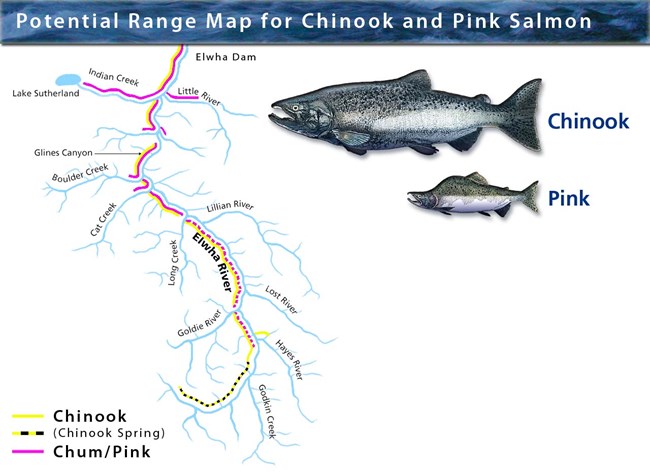
Chinook and Pink Salmon in the Elwha River Over the next few months, fisheries biologists expect 1,500-2,500 Chinook and up to 200 pink salmon to move into the Elwha River. Some of these fish may make their way upstream, past the former site of the Elwha Dam, and into the clear waters of Little River and Indian Creek, but most of the Chinook will be collected downstream of the dams and relocated to the Washington State Department of Fish and Wildlife rearing channel. Even with Elwha dam gone, most of the Elwha River is still blocked by Glines Canyon Dam, making the upstream clear waters inaccessible. Smaller species of salmon, such as coho and pinks, can move successfully upstream into the clear waters of Little River and Indian Creek to spawn, but the Chinook are generally too large to use these small tributaries in any significant numbers. Weighing in at an average of 20-40 pounds, Chinook are the salmon of legends. Prior to dam construction, historical records tell of a river teeming with Chinook, some weighing up to 100 pounds. Even today, biologists still observe an occasional 50-70 pound Chinook in the Elwha River. Until both dams are gone, these legendary fish will get some help from fisheries biologists to ensure that this year's cohort continue their life cycle and the next generation of Chinook has a chance to return to an undammed Elwha River when their time comes. While the Chinook may not make it to the upper reaches of the Elwha River this year, if dam removal remains on schedule, this will be the last year they won't have access to the watershed above Glines Canyon Dam.
River Story Events Continue at the Port Angeles Library On Wednesday, August 8 at 7pm, Joshua Chenoweth, Olympic National Park Restoration Botanist, will discuss the Elwha re-vegetation project at the Port Angeles Library. Last year, over 30,000 seedlings were planted in the newly uncovered sediments of the old reservoirs. July 26, 2012 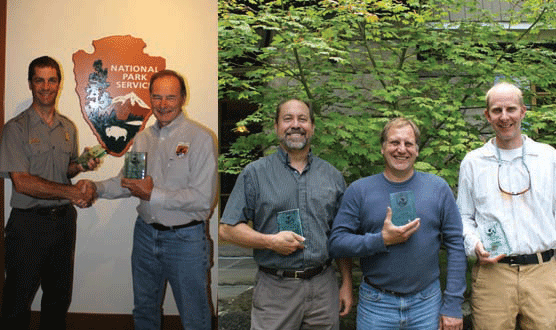
On Tuesday, July 24, Michael Carrier, from U.S. Fish and Wildlife Service (USFWS), visited Olympic National Park to present Brian Winter, Pat Crain, and Sam Brenkman with their Recovery Champion awards. A fourth award was accepted by Todd Suess, Acting Superintendent of Olympic National Park, on behalf of Karen Gustin, former Superintendent of the park. The Recovery Champion award honors USFWS employees and partners for outstanding efforts to conserve and protect endangered and threatened species of fish, wildlife, and plants. The awards were announced in March of this year. Brenkman, Crain, Gustin, and Winter were honored for their leadership in removing the Elwha and Glines Canyon dams on the Elwha River. Removal of these dams will provide Puget Sound Chinook salmon and steelhead, listed as threatened species, with access to over 70 miles of pristine habitat, as well as open migratory corridors to anadromous bull trout, for the first time in 100 years. The restoration of the Elwha River ecosystem will fuel the recovery of these listed fish species, as well as the wildlife species that depend on them. For information about the 2011 Recovery Champions, please visit: http://www.fws.gov/endangered/what-we-do/recovery-champions/index.html. Fourteen Day Hold to End at Glines Canyon Dam on Saturday July 20, 2012 
Up in the sky…It's a bird, it's a plane! No, it's not Superman. But there have been some pretty super science machines soaring in the skies above the Elwha River. (Will be accompanied by photos of aircraft with caption) Staff from the Bureau of Reclamation (USBR), United States Geological Survey (USGS), NatureBridge, and Olympic National Park, as well as researchers from Western Carolina University, have been sending cameras up into the sky to capture images of the sediment changes happening along the Elwha River during dam removal. These images are helping project managers and researchers monitor, map, and understand sediment changes along the river as the dams come down. Sediment management may not be as compelling as spawning coho or plant seedlings, but it is a critical component of the Elwha River Restoration project. Approximately 25 million cubic yards of sediment, enough sediment to fill a football field 45 stories high, were trapped in Lake Mills and Lake Aldwell. As the dams are removed, much of this sediment will be released and re-deposited downstream, re-building beaches, providing substrate for new plant growth, and creating important spawning habitat for salmon. Habitat for freshwater invertebrates and nearshore species, such as clams, crabs and smelt will also be re-built. To help manage the sediment release, work to lower Glines Canyon Dam has paused until July 29 for a fourteen-day hold. During periods of active dam lowering, water is released from the Lake Mills reservoir and the river erodes the delta sediment vertically, incising into the sediment and creating terraces. During hold periods, the reservoir level remains steady and the river moves and erodes laterally across the newly exposed lakebed surface, eroding the terraces and newly exposed delta sediment and moving the sediments forward. By monitoring the sediment and managing its release, project managers are working to restore the ecosystem with the least amount of harm to the resources during the dam removal process. During the last two months, four research and monitoring groups sent camera-equipped aircraft into the skies above Lake Aldwell and Lake Mills to capture images and video of the dynamic changes to the sediment during the dam removal process. The National Park Service has attached a camera to a Cessna to capture and monitor river morphology during the Elwha River Restoration Project. USGS and USBR have sent a Raven Unmanned Aerial Vehicle (UAV) up to capture video of the shifting topography along the Elwha River, which is being used to create ortho-rectified imagery. And researchers from Western Carolina University and students from NatureBridge are using a camera equipped balloons to capture images of the shifting sediment. Each image captured from these unique aircraft adds to our understanding of the science of dam removal, as well as the potential applications of the aerial technology for future research. Blasting at Glines Canyon Dam Pauses for 14-Day Hold |
Last updated: February 28, 2015
